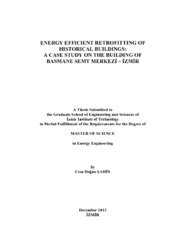Please use this identifier to cite or link to this item:
https://hdl.handle.net/11147/3666Full metadata record
| DC Field | Value | Language |
|---|---|---|
| dc.contributor.advisor | Gökçen Akkurt, Gülden | - |
| dc.contributor.author | Şahin, Cem Doğan | - |
| dc.date.accessioned | 2014-07-22T13:52:05Z | - |
| dc.date.available | 2014-07-22T13:52:05Z | - |
| dc.date.issued | 2013 | - |
| dc.identifier.uri | http://hdl.handle.net/11147/3666 | - |
| dc.description | Thesis (Master)--Izmir Institute of Technology, Energy Engineering, Izmir, 2013 | en_US |
| dc.description | Includes bibliographical references(leaves: 78-85) | en_US |
| dc.description | Text in English; Abstract: Turkish an English | en_US |
| dc.description | xii, 85 leaves | en_US |
| dc.description | Full text release delayed at author's request until 2016.01.17 | en_US |
| dc.description.abstract | Buildings account for 40% of total energy consumption in the European Union yet at the same time it is foreseen that they have a considerable energy saving potentials. Along with the issued energy efficiency related laws and regulations, energy efficient retrofitting applications of the existing buildings are getting increased and the new buildings are built considering the energy efficiency issues. At this point, historical buildings should be treated different than contemporary ones when energy efficient improvements matter. Therefore the specifications adding value to the historical buildings require attention and well-preservation while saving energy. The purpose of this study is to denote how the energy efficient retrofitting in historical buildings should be managed in a transdisciplinary way with a case study conducted on a historical building, Basmane Semt Merkezi-İzmir. A detailed building energy simulation tool, DesignBuilder, was used to determine the impacts of the energy efficient retrofits. The actual energy consumption of the case building was calculated obtaining the utility bills regarding electricity and heating fuel consumption. Building energy simulation tool was calibrated by comparing of the measured and simulated indoor air temperatures and total energy consumptions. The inappropriate retrofits, which contradict to the heritage and cultural values, were eliminated with an interdisciplinary approach. Later appropriates retrofits were gathered into three packages to evaluate their effects on the energy consumption. The results show that energy saving up to 41% can be obtained without damaging the heritage values. Besides, the results of combined and aggregated effects of single retrofits show considerable alterations that might cause errors in economical calculations. | en_US |
| dc.language.iso | en | en_US |
| dc.publisher | Izmir Institute of Technology | en_US |
| dc.rights | info:eu-repo/semantics/openAccess | en_US |
| dc.subject.lcsh | Historic buildings--Energy conservation | en |
| dc.title | Energy Efficient Retrofitting of Historical Buildings: a Case Study on the Building of Basmane Semt Merkezi-Izmir | en_US |
| dc.type | Master Thesis | en_US |
| dc.authorid | 0000-0002-0675-460X | - |
| dc.institutionauthor | Şahin, Cem Doğan | - |
| dc.department | Thesis (Master)--İzmir Institute of Technology, Energy Systems Engineering | en_US |
| dc.relation.publicationcategory | Tez | en_US |
| dc.identifier.wosquality | N/A | - |
| dc.identifier.scopusquality | N/A | - |
| item.openairecristype | http://purl.org/coar/resource_type/c_18cf | - |
| item.languageiso639-1 | en | - |
| item.openairetype | Master Thesis | - |
| item.grantfulltext | open | - |
| item.fulltext | With Fulltext | - |
| item.cerifentitytype | Publications | - |
| crisitem.author.dept | 01. Izmir Institute of Technology | - |
| Appears in Collections: | Master Degree / Yüksek Lisans Tezleri | |
Files in This Item:
| File | Description | Size | Format | |
|---|---|---|---|---|
| 10024670.pdf | MasterThesis | 4.05 MB | Adobe PDF |  View/Open |
CORE Recommender
Page view(s)
366
checked on Mar 31, 2025
Download(s)
272
checked on Mar 31, 2025
Google ScholarTM
Check
Items in GCRIS Repository are protected by copyright, with all rights reserved, unless otherwise indicated.